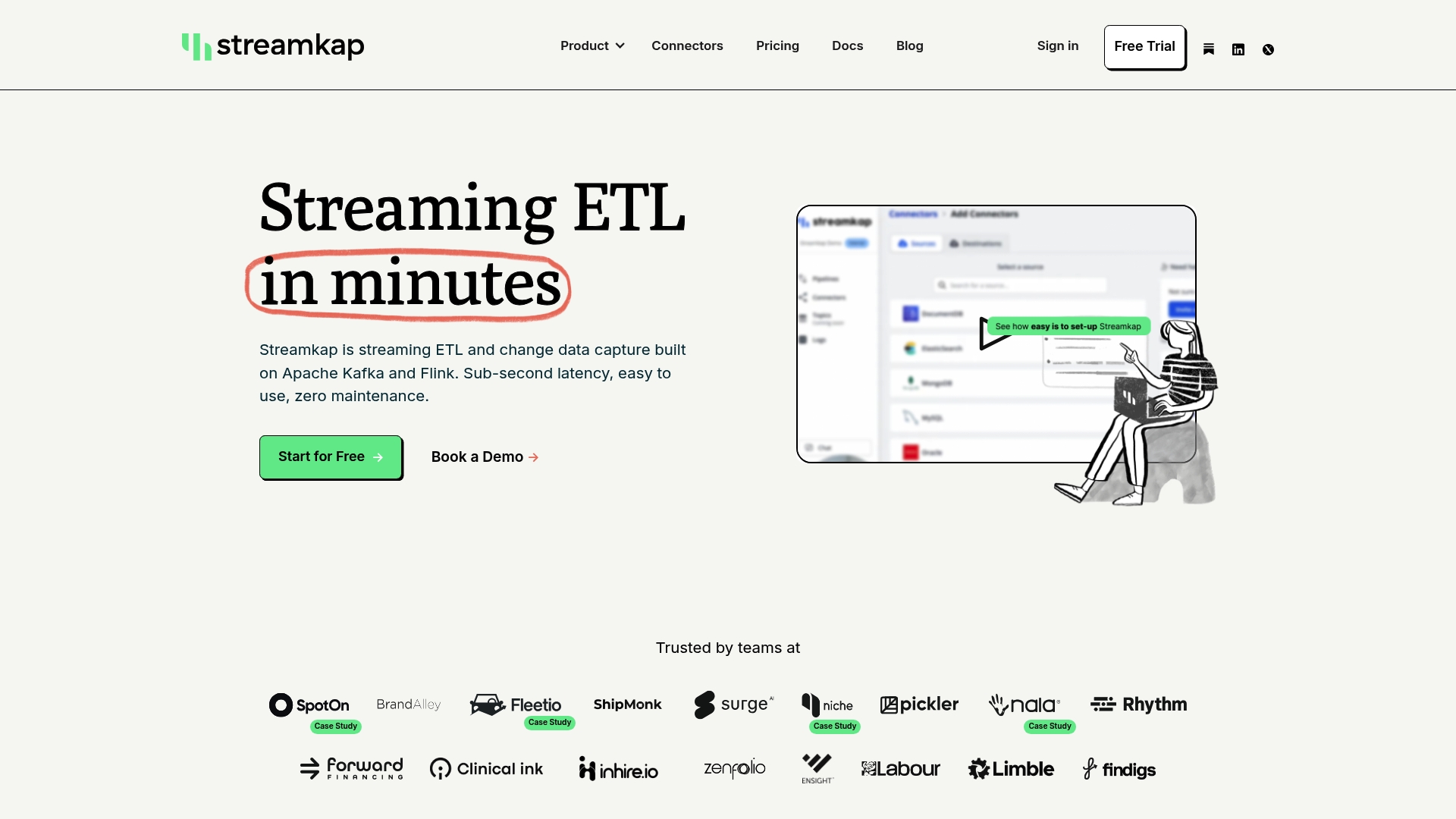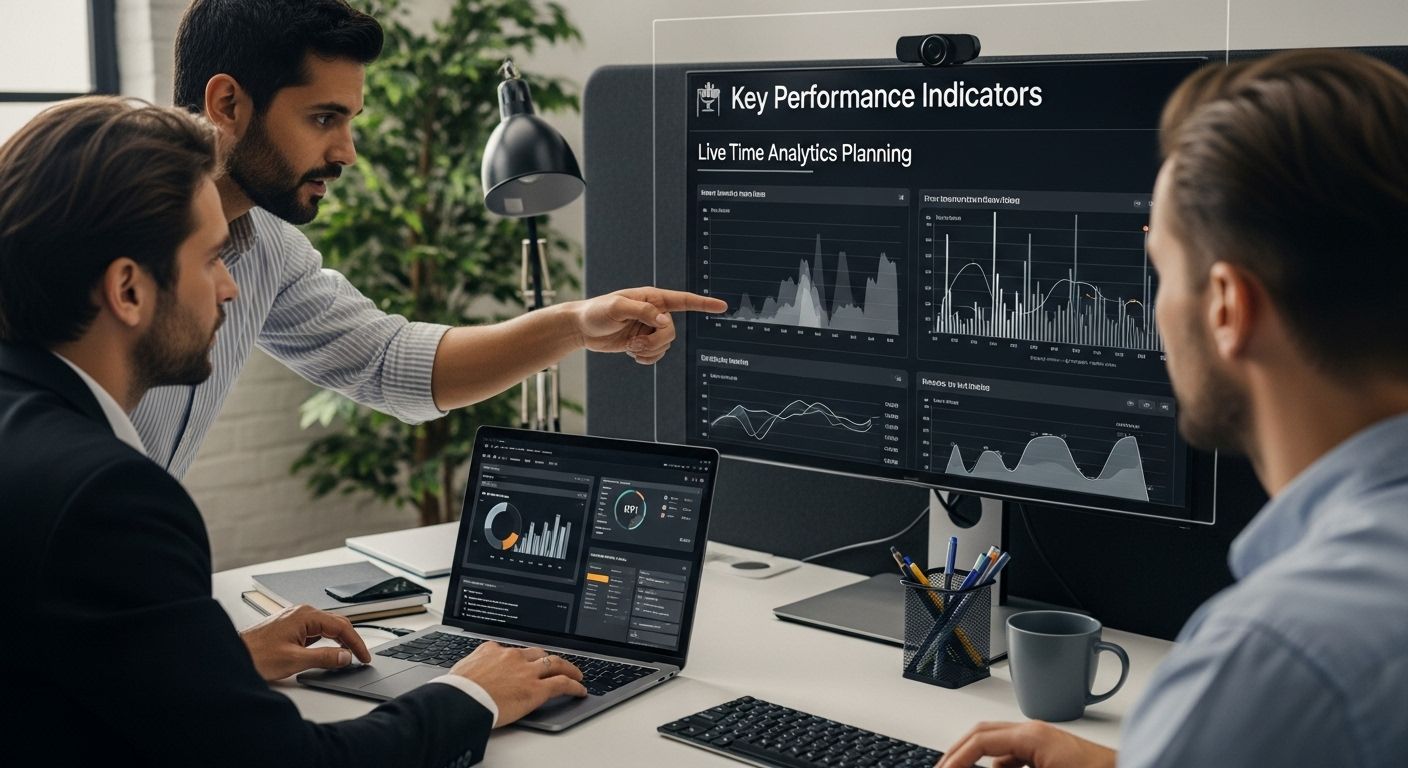Master Your Real-Time Analytics Workflow for 2025

August 25, 2025
Building a real-time analytics workflow sounds like a massive technical puzzle. Companies that get it right can unlock findings in seconds and create a self-healing analytics system that learns and adapts all on its own. Most teams picture endless complexity or think it is out of reach. But the path to a truly dynamic, real-time workflow is often a lot more practical—and even more powerful—than you expect.
Table of Contents
Quick Summary
| Key Point | Explanation |
| 1. Define Clear KPIs | Establish specific, measurable, and relevant KPIs to guide your data performance efforts. |
| 2. Build Robust Data Infrastructure | Create an interoperable system that supports seamless data processing and integration across sources. |
| 3. Select Effective Processing Tools | Choose tools that can manage high-velocity data transformations with minimal latency for optimal performance. |
| 4. Utilize Visualization Tools | Implement dynamic visualization solutions to transform complex data into comprehensible, actionable insights. |
| 5. Monitor and Optimize Continuously | Regularly audit performance, adapt resources, and apply optimizations to maintain peak system efficiency. |
Step 1: Define Your Key Performance Indicators
Defining key performance indicators (KPIs) forms the strategic foundation of your real-time analytics workflow. This critical first step determines how effectively you will measure, track, and optimize your data performance. Without precise KPIs, your analytics efforts become unfocused and inefficient.
Successful KPI definition requires a systematic approach that aligns technical capabilities with business objectives. Start by conducting a comprehensive organizational assessment that identifies core metrics most relevant to your specific data infrastructure. This means thoroughly understanding your current data processes, performance bottlenecks, and strategic goals.
The selection process demands collaboration between data engineers, business intelligence teams, and senior leadership. Prioritize indicators that are quantifiable, actionable, and directly tied to strategic outcomes. These might include metrics like data processing latency, pipeline throughput, error rates, or transformation accuracy.
According to National Academies Press, effective performance measurement systems require clearly defined goals that are objective and statistically reliable. This means your chosen KPIs must be:
-
Specific: Precisely defined and unambiguous
-
Measurable: Quantifiable with clear numerical representations
-
Relevant: Directly connected to organizational objectives
-
Time-bound: Capable of tracking performance over specific intervals
Consider establishing a tiered KPI framework that captures both macro and micro performance perspectives. At the macro level, track overall system efficiency and reliability. At the micro level, drill down into granular metrics that reveal specific workflow bottlenecks or optimization opportunities.
Remember that KPI selection is not a one-time event but an ongoing process. Plan to review and recalibrate your indicators quarterly, ensuring they remain aligned with evolving technological capabilities and business strategies. By creating a dynamic, responsive KPI framework, you build a robust foundation for continuous improvement in your real-time analytics workflow.
Step 2: Set Up Your Data Infrastructure
Building a robust data infrastructure represents the critical backbone of your real-time analytics workflow. This step transforms your strategic KPIs into a functional, scalable technical environment capable of capturing, processing, and analyzing data with precision and speed.
Begin by evaluating your current technological ecosystem. Identify existing data sources, potential integration points, and potential bottlenecks. This assessment requires a comprehensive review of databases, streaming platforms, cloud services, and legacy systems that currently manage your organizational data. The goal is to create a unified, interoperable infrastructure that supports seamless data movement and transformation.
Cloud-based platforms offer significant advantages for modern data infrastructures. Select solutions that provide high-performance computing, elastic scalability, and built-in security features. Look for platforms supporting multiple data formats, real-time processing capabilities, and robust integration mechanisms. Prioritize technologies that offer low-latency data streaming and automated schema management.
According to National Academies Press, successful data infrastructure development requires establishing clear governance structures and standardized processes. This means defining roles, creating documentation, and implementing consistent data handling protocols across your organization.
Consider implementing a flexible data streaming solution that can adapt to your evolving technological landscape. Your infrastructure should support multiple data sources, enable real-time transformations, and provide comprehensive monitoring capabilities.
Key infrastructure components should include:
-
Streaming platforms for continuous data ingestion
-
Transformation engines capable of real-time processing
-
Storage solutions with high-performance query capabilities
-
Monitoring and alerting systems for immediate performance tracking
Verify your infrastructure setup by running comprehensive test scenarios that simulate your expected data workflows. This validation ensures your technical environment can handle anticipated data volumes, processing complexities, and performance requirements. Successful infrastructure setup means creating a flexible, resilient system ready to support your organization’s most demanding real-time analytics challenges.

Step 3: Configure Real-Time Data Processing Tools
Configuring real-time data processing tools represents the technical heart of your analytics workflow. This critical step transforms raw data streams into actionable insights, requiring precise tool selection and strategic configuration that aligns with your organizational performance indicators.
Modern data processing demands tools that can handle high-velocity, complex data transformations with minimal latency. Begin by evaluating stream processing frameworks that support your specific data ecosystem. Apache Kafka, Apache Flink, and Apache Spark Streaming emerge as leading technologies capable of managing intricate real-time data scenarios.
Understanding the nuanced differences between processing approaches becomes paramount. Learn the critical distinctions between batch and stream processing to optimize your configuration strategy. Your selected tools must provide flexibility in handling various data f
Here is a quick comparison table of major real-time data processing tools mentioned in the article, summarizing their core features and optimal use cases to help you select the right platform for your needs.
| Tool | Key Features | Best Suited For |
| Apache Kafka | Scalable streaming, fault-tolerant, CDC | Event streaming, real-time ingestion |
| Apache Flink | Complex event processing, low-latency | Stateful stream analytics |
| Apache Spark Streaming | Batch & micro-batch, flexible integrations | Unified batch and stream workloads |
ormats, support complex event processing, and enable dynamic schema evolution.
Consider implementing a multi-layered processing architecture that separates data ingestion, transformation, and delivery stages. Select tools that offer native support for change data capture (CDC), enabling real-time tracking of data modifications across source systems. This approach ensures your processing framework can capture incremental changes without expensive full-data reloads.
Key configuration considerations include:
-
Defining precise data transformation rules
-
Establishing robust error handling mechanisms
-
Implementing efficient data routing strategies
-
Creating scalable processing pipelines
Pay close attention to performance tuning parameters such as parallelism, buffer sizes, and windowing strategies. These technical configurations directly impact your processing speed and resource efficiency. Experiment with different settings, monitoring system performance and adjusting configurations to optimize throughput and minimize latency.
Verify your processing tool configuration by running comprehensive test scenarios that simulate your actual data workloads. Successful configuration means achieving consistent, low-latency data transformations that meet your predefined performance indicators while maintaining system stability and scalability.

Step 4: Implement Data Visualization Solutions
Data visualization transforms complex real-time analytics into actionable, comprehensible insights. This crucial step bridges the gap between raw data processing and strategic decision-making, enabling organizations to understand intricate patterns and trends instantly.
Selecting the right visualization tools requires a strategic approach that balances technical capabilities with user experience. Modern visualization platforms must support interactive dashboards, real-time data streaming, and customizable reporting interfaces. Look for solutions that offer intuitive design, cross-platform compatibility, and seamless integration with your existing data processing infrastructure.
According to National Institute of Standards and Technology, effective visualization platforms should provide open-source flexibility and robust analytics capabilities. Focus on tools that enable dynamic data exploration, allowing users to drill down into specific metrics, filter complex datasets, and generate immediate visual representations.
Consider implementing visualization solutions that support multiple data representation formats. Prioritize platforms offering diverse visualization types such as time-series charts, heat maps, geographical representations, and network graphs. These varied formats help different stakeholders interpret data according to their specific analytical needs.
Key visualization design principles include:
-
Creating clear, intuitive visual hierarchies
-
Ensuring color-blind friendly color schemes
-
Designing responsive interfaces for multiple device types
-
Implementing real-time data refresh mechanisms
Authentication and security represent critical considerations in visualization tool selection. Implement role-based access controls that restrict data visibility based on organizational hierarchies. This approach ensures sensitive information remains protected while providing appropriate access to relevant team members.
Verify your visualization solution by conducting comprehensive user acceptance testing. Successful implementation means creating dashboards that immediately communicate complex data insights, enable rapid decision-making, and provide seamless, intuitive user experiences. Your visualization tools should transform raw data streams into meaningful, actionable visual narratives that drive organizational strategy.
Step 5: Test and Validate Your Analytics Workflow
Testing and validating your real-time analytics workflow represents the critical quality assurance phase that ensures your entire system performs precisely as designed. This step transforms theoretical configurations into a reliable, high-performance data processing environment through systematic and comprehensive verification processes.
Comprehensive testing requires a multifaceted approach that simulates diverse real-world data scenarios. Begin by developing a robust test suite that covers multiple dimensions of your analytics workflow. This includes performance testing, data integrity checks, error handling scenarios, and scalability assessments. Simulate extreme conditions such as high-volume data streams, unexpected data format variations, and potential system bottlenecks.
According to Observational Health Data Sciences and Informatics, successful validation involves developing predictive models and conducting rigorous external testing across different datasets. Implement a staged testing strategy that progressively evaluates your workflow from component-level assessments to full system integration tests.
Utilize synthetic and historical datasets to validate your workflow’s accuracy and performance. Create test scenarios that mirror your actual production environment, ensuring your analytics pipeline can handle complex, real-world data transformations. Pay special attention to edge cases, data anomalies, and potential system failure points.
Key validation checkpoints include:
-
Verifying data transformation accuracy
-
Measuring end-to-end processing latency
-
Assessing system resilience under stress conditions
-
Confirming data security and compliance mechanisms
Implement continuous monitoring tools that provide real-time insights into your workflow’s performance. These tools should offer granular metrics, automatic alerting mechanisms, and comprehensive logging capabilities. By establishing a proactive monitoring approach, you can quickly identify and address potential issues before they impact system reliability.
Below is a practical checklist for validating your real-time analytics workflow, drawn from the essential verification and monitoring steps described. Use this table to ensure your system meets reliability and performance standards before deployment.
| Validation Step | What to Check | Pass/Fail |
| Transformation Accuracy | Are data transformations precise? | |
| End-to-End Processing Latency | Does workflow meet expected speed benchmarks? | |
| System Resilience Under Stress | Does system recover from high loads? | |
| Error Handling Mechanisms | Are failures detected and managed gracefully? | |
| Data Security & Compliance | Is sensitive data protected appropriately? | |
| Continuous Monitoring and Alerts | Are monitoring tools active and reliable? |
Successful validation means developing a self-healing, adaptive analytics workflow that consistently delivers accurate, timely insights. Your testing process should not just confirm current performance but also provide a framework for ongoing optimization and continuous improvement.
Step 6: Monitor and Optimize Performance
Monitoring and optimizing performance represents the continuous improvement phase of your real-time analytics workflow. This critical step transforms your initial configuration into a dynamic, self-evolving system that consistently delivers peak efficiency and insights.
Performance optimization requires a proactive, data-driven approach that goes beyond traditional monitoring techniques. Implement advanced observability platforms that provide comprehensive visibility into every aspect of your data processing pipeline. These tools should offer granular metrics tracking, predictive anomaly detection, and automated performance recommendations.
Establish a robust monitoring framework that captures both technical infrastructure metrics and business-level performance indicators. Track key parameters such as data processing latency, throughput rates, resource utilization, and error rates. Create dashboards that provide real-time insights into system health, enabling rapid identification and resolution of potential bottlenecks.
Develop a systematic optimization strategy that involves regular performance audits and incremental improvements. This means conducting periodic deep-dive analysis of your workflow, identifying inefficient processing patterns, and implementing targeted optimizations. Consider leveraging machine learning techniques that can automatically suggest performance tuning recommendations based on historical system behavior.
Critical optimization focus areas include:
-
Reducing data processing latency
-
Minimizing computational resource consumption
-
Improving data transformation efficiency
-
Enhancing system scalability
Implement adaptive scaling mechanisms that can automatically adjust computational resources based on real-time workload demands. This dynamic resource allocation ensures your analytics workflow remains cost-effective and responsive, preventing both over-provisioning and performance degradation during peak processing periods.
Successful performance monitoring means creating a self-optimizing analytics ecosystem that continuously learns, adapts, and improves. Your approach should transform performance optimization from a periodic task into an ongoing, intelligent process that drives consistent operational excellence.
Ready to Eliminate Bottlenecks in Your Real-Time Analytics?
Struggling with data processing latency, complex infrastructure, or unreliable integrations as you modernize your analytics for 2025? The article shows how vital clear KPIs, low-latency streaming, and real-time transformation truly are. Yet traditional ETL is holding teams back, from expensive resource demands to slow reaction times. You deserve a workflow that simply works – one that lets your data flow in real time, with instant insights and zero complexity.

Why wait for another cycle of outdated batch jobs or the risk of pipeline errors? Streamkap gives you the confidence and tools to deliver continuous analytics with sub-second latency, no-code connectors, and easy CDC integration. Unleash your full data potential today. See how industry leaders use real-time streaming ETL to optimize every step from data ingestion to actionable dashboards. Start transforming your analytics workflow and stay ahead now – visit Streamkap to experience the future of data movement.
Frequently Asked Questions
What are Key Performance Indicators (KPIs) in real-time analytics?
KPIs are measurable values that determine the effectiveness of your analytics efforts, directly tied to your strategic business objectives. They help you track and optimize data performance.
How do I set up a robust data infrastructure for real-time analytics?
Begin by evaluating your existing data sources and technology ecosystem. Choose cloud-based platforms that offer high performance, scalability, and integration capabilities to ensure seamless data movement and processing.
What tools are essential for real-time data processing?
Key tools include stream processing frameworks like Apache Kafka, Apache Flink, and Apache Spark Streaming. These enable handling high-velocity data transformations with minimal latency.
How can I optimize the performance of my analytics workflow?
Implement a monitoring framework to track critical metrics and establish a routine for performance audits. Use machine learning techniques for automated suggestions on performance tuning based on historical data.
Recommended


